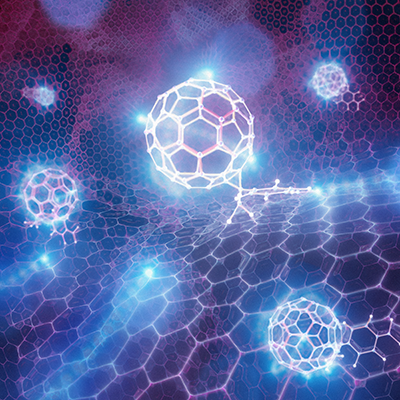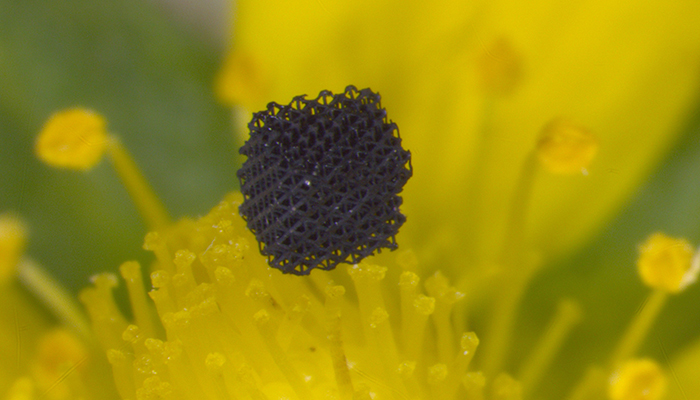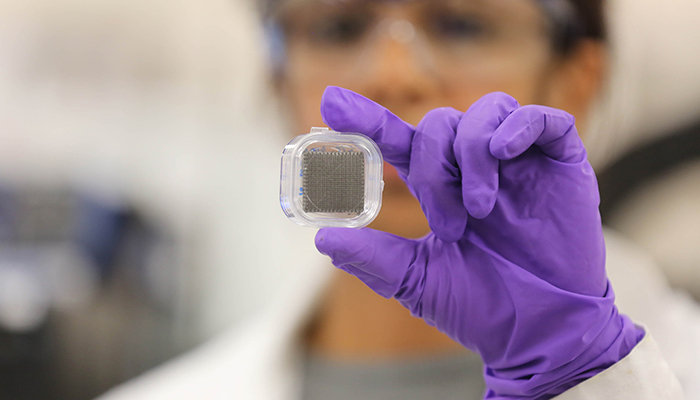Researchers at LLNL are pursuing strategies to improve the capacitive performance of graphene based materials.
Development of novel technologies for electric energy storage is critical for the widespread adoption of emission-free energy sources, such as solar and wind, for electricity generation. Supercapacitors offer a promising technology due to their intrinsic high power densities that enable fast charging and discharging. Unlike conventional batteries, supercapacitors store energy via the formation of an electric double layer at the interface with the electrode.
Researchers are interested in employing graphene-based materials for supercapacitor electrodes, as they feature high surface area, good electrical conductivity, and chemical inertness. However, for practical applications, energy storage performance of these materials requires further improvements, as their interfacial capacitance is often limited by the low density of electronic states for charge storage.
To address these limitations, we are exploring the following strategies:
Fullerenes are characterized by their high electron affinity, which makes them interesting as electron acceptors. We focus on achieving a fundamental understanding of the interaction between 3D graphene networks and fullerenes, specifically in the context of stability and charge transfer in an electrochemical environment.
Our project demonstrated that the double layer capacity of the 3D graphene network is significantly improved upon the addition of carbon 60 (C60) and C60 monoadducts by providing additional acceptor states in the form of the low-lying lowest unoccupied molecular orbitals (LUMOs) of C60 and its derivate. Guided by experimental results and first-principle calculations, we synthesized and tested a variety of different C60 monoadducts, demonstrating that the stability can be increased by strengthening the van der Waals interactions.
Using atomistic simulations, we also showed that the introduction of C60 molecules significantly alters the electric double layer response through a complex interplay between surface morphology and charge localization character, which ultimately dominates the overall capacitive improvement in the hybrid system.
Our synthesis method and stabilization strategy are expected to benefit the integration of graphene/C60 hybrid materials in solar cell and charge storage applications.
Publications
M.R. Cerón, C. Zhan, P.G. Campbell, M.C. Freyman, C. Santoyo, L. Echegoyen, B.C. Wood, J. Biener, T.A. Pham, and M.M. Biener, Integration of Fullerenes as Electron Acceptors in 3D Graphene Networks: Enhanced Charge Transfer and Stability through Molecular Design, ACS Appl. Mater. Interfaces 11, 28818 (2019). Featured on cover: August 2019
C. Zhan, T.A. Pham, M. Otani, D.-e. Jiang, M.R. Ceron, P.G. Campbell, V. Vedharathinam, J. Biener, B.C. Wood, M. Biener, Origins and Implications of Interfacial Capacitance Enhancements in C60-Modified Graphene Supercapacitors, ACS Appl. Mater. Interfaces 10, 36860 (2018).
People
Macro-assemblies of graphene exhibit physicochemical property attenuation compared to their 2D building blocks because of one-fold composition and tortuous, stochastic porous networks. These limitations can be offset by developing a graphene composite material with an engineered porous architecture.
We fabricated 3D periodic graphene composite aerogel microlattices for supercapacitor applications through a 3D printing technique known as direct-ink writing. The key factor in developing these novel aerogels is creating an extrudable graphene oxide-based composite ink and modifying the 3D printing method to accommodate aerogel processing. The 3D-printed graphene composite aerogel (3D-GCA) electrodes are lightweight, highly conductive, and exhibit excellent electrochemical properties. In particular, the supercapacitors using these 3D-GCA electrodes with thicknesses on the order of millimeters display exceptional capacitive retention and power densities that equal or exceed those of reported devices made with electrodes 10–100 times thinner.
We are working to further improve the capacitance of 3D-printed graphene aerogels while still retaining their excellent rate capability. This method involves two ion‐intercalation steps (lithium‐ion intercalation and perchlorate‐ion intercalation) followed by hydrolysis of perchlorate ion intercalation compounds. Lithium ion intercalation mainly leads to surface exfoliation, while the hydrolysis of perchlorate ion intercalation compounds functionalize the graphene surface with oxygen moieties. Electrochemically treated graphitic paper electrodes show 1000 times enhancement in areal capacitance.
Polypyrrole (PPy) is one of the most widely used pseudocapacitive materials, which generally boosts specific capacitance of graphene through synergetic effects. We demonstrated a facile strategy for creating PPy–GA composite‐based, highly compressible electrodes with designed 3D shapes and architectures. The 3D printed GA scaffolds facilitate the chemical deposition of PPy. The addition of PPy not only greatly increases the specific capacitance but also enhances the mechanical properties. This concept will open a new paradigm for the fabrication of arbitrarily shaped, deformable 3D GA‐based composite supercapacitors and broaden their range of applications.
Publications
Z. Qi, J. Ye, W. Chen, J. Biener, E.B. Duoss, C.M. Spadaccini, M.A. Worsley, C. Zhu, 3D-Printed, Superelastic Polypyrrole–Graphene Electrodes with Ultrahigh Areal Capacitance for Electrochemical Energy Storage, Adv. Mat. Tech. 3, 1800053 (2018). Featured on cover: July 2018
R.M. Hensleigh, H. Cui, J.S. Oakdale, J.C. Ye, P.G. Campbell, E.B. Duoss, C.M. Spadaccini, X. Zheng, M.A. Worsley, Additive manufacturing of complex micro-architected graphene aerogels, Materials Horizons 5, 1035 (2018). Featured on cover: November 2018
T. Liu, Y. Li, M.A. Worsley, T. Zhai (Eds.), Focus Issue: Porous Carbon and Carbonaceous Materials for Energy Conversion and Storage, Journal of Materials Research 33, 1057 (2018). Featured on cover: May 2018
C. Zhu, T. Liu, F. Qian, W. Chen, S. Chandrasekaran, B. Yao, Y. Song, E.B. Duoss, J.D. Kuntz, C.M. Spadaccini, M.A. Worsley, Y. Li, 3D printed functional nanomaterials for electrochemical energy storage, Nano Today 15, 107 (2017).
T. Liu, C. Zhu, T. Kou, M.A. Worsley, F. Qian, C. Condes, E.B. Duoss, C.M. Spadaccini, Y. Li, Ion Intercalation Induced Capacitance Improvement for Graphene-Based Supercapacitor Electrodes, ChemNanoMat 2, 635 (2016). Featured on cover: July 2016
C. Zhu, T. Liu, F. Qian, T.Y.-J. Han, E.B. Duoss, J.D. Kuntz, C.M. Spadaccini, M.A. Worsley, Y. Li, Supercapacitors Based on Three-Dimensional Hierarchical Graphene Aerogels with Periodic Macropores, Nano Lett. 16, 3448 (2016). Featured on cover: June 2016
C. Zhu, T.Y.-J. Han, E.B. Duoss, A.M. Golobic, J.D. Kuntz, C.M. Spadaccini, M.A. Worsley, Highly compressible 3D periodic graphene aerogel microlattices, Nat. Communi. 6, 6962 (2015).
M. Bagge-Hansen, B.C. Wood, T. Ogitsu, T.M. Willey, I.C. Tran, A. Wittstock, M.M. Biener, M.D. Merrill, M.A. Worsley, M. Otani, C.H. Chuang, D. Prendergast, J.H. Guo, T.F. Baumann, T. van Buuren, J. Biener, J.R.I. Lee, Supercapacitors: Potential‐Induced Electronic Structure Changes in Supercapacitor Electrodes Observed by In Operando Soft X‐Ray Spectroscopy, Adv. Mater. 27, 1512 (2015). Featured on cover: March 2015
J. Biener, S. Dasgupta, L. Shao, D. Wang, M.A. Worsley, A. Wittstock, J.R.I. Lee, M.M. Biener, C.A. Orme, S.O. Kucheyev, B.C. Wood, T.M. Willey, A.V. Hamza, J. Weissmüller, H. Hahn, T.F. Baumann, Macroscopic 3D Nanographene with Dynamically Tunable Bulk Properties, Advanced Materials 24, 5017 (2012). Featured on cover: September 2012
People
Commercial supercapacitors, while excelling in power density (fast charge/discharge), generally suffer from low energy densities (overall storage capacity). Pseudocapacitors are an important class of energy storage devices that could balance the need of high energy density and fast charging/discharging. Among many pseudocapacitive materials, manganese oxide (MnO2) stands out for its high theoretical specific capacitance, wide availability, and environmental friendliness. Researchers have employed various strategies to improve the capacitive performance of MnO2, including crystallinity engineering, crystal structure selection, morphology control, defect introduction and elemental doping.
Electrodes with small mass loadings of MnO2 provided excellent specific capacitance. However, increasing MnO2 loading often causes severe deterioration of capacitive performance due to inefficient electron transport and ion diffusion. Deposition of MnO2 nanomaterials onto conductive and high surface area current collectors have proven to be an effective way to improve electron transport, but they are less effective in addressing the sluggish ion diffusion in thick MnO2 films, especially for thick electrodes.
Recent advances in 3D printing technologies offer new possibilities in addressing this outstanding challenge for pseudocapacitors. Our previous studies show that a 3D printed carbon electrode demonstrates improved rate capability compared its bulk counterpart. The enhancement may have been due to periodic macropores, which facilitate the diffusion of electrolyte ions, and thus, improve the electric double layer capacitance at high current densities. Subsequently, we demonstrated that 3D printed carbon aerogels also serve as good scaffolds for pseudocapacitive materials, enabling even record-high loadings of MnO2 on electrodes several millimetres thick.
Publications
B. Yao, S. Chandrasekaran, H. Zhang, A. Ma, J. Kang, L. Zhang, X. lu, F. Qian, C. Zhu, E.B. Duoss, C.M. Spadaccini, M.A. Worsley, Y. Li, 3D Printed Structure Boost the Kinetics and Intrinsic Capacitance of Pseudocapacitive Graphene Aerogels, Advanced Materials 32, 1906652 (2020).
B. Yao, S. Chandrasekaran, J. Zhang, W. Xiao, F. Qian, C. Zhu, E.B. Duoss, C.M. Spadaccini, M.A. Worsley, Y. Li, Efficient 3D Printed Pseudocapacitive Electrodes with Ultrahigh MnO2 Loading, Joule 3, 459 (2019).
Z. Qi, J. Ye, W. Chen, J. Biener, E.B. Duoss, C.M. Spadaccini, M.A. Worsley, C. Zhu, 3D-Printed, Superelastic Polypyrrole–Graphene Electrodes with Ultrahigh Areal Capacitance for Electrochemical Energy Storage, Adv. Mat. Tech. 3, 1800053 (2018). Featured on cover: July 2018
S. Chandrasekaran, B. Yao, T. Liu, W. Xiao, Y. Song, F. Qian, C. Zhu, E.B. Duoss, C.M. Spadaccini, Y. Li, M.A. Worsley, Direct ink writing of organic and carbon aerogels, Materials Horizons 5, 1166 (2018).
Y. Song, T. Liu, F. Qian, C. Zhu, B. Yao, E. Duoss, C. Spadaccini, M. Worsley, Y. Li, Three-dimensional carbon architectures for electrochemical capacitors, Journal of Colloid and Interface Science 509, 529 (2018). Featured on cover: February 2018
C. Zhu, T. Liu, F. Qian, W. Chen, S. Chandrasekaran, B. Yao, Y. Song, E.B. Duoss, J.D. Kuntz, C.M. Spadaccini, M.A. Worsley, Y. Li, 3D printed functional nanomaterials for electrochemical energy storage, Nano Today 15, 107 (2017).
S. Chandrasekaran, P.G. Campbell, T.F. Baumann, M.A. Worsley, Carbon aerogel evolution: Allotrope, graphene-inspired, and 3D-printed aerogels, Journal of Materials Research 32, 4166 (2017).
T. Liu, C. Zhu, T. Kou, M.A. Worsley, F. Qian, C. Condes, E.B. Duoss, C.M. Spadaccini, Y. Li, Ion Intercalation Induced Capacitance Improvement for Graphene-Based Supercapacitor Electrodes, ChemNanoMat 2, 635 (2016). Featured on cover: July 2016
C. Zhu, T. Liu, F. Qian, T.Y.-J. Han, E.B. Duoss, J.D. Kuntz, C.M. Spadaccini, M.A. Worsley, Y. Li, Supercapacitors Based on Three-Dimensional Hierarchical Graphene Aerogels with Periodic Macropores, Nano Lett. 16, 3448 (2016). Featured on cover: June 2016
P.G. Campbell, M.D. Merrill, B.C. Wood, E. Montalvo, M.A. Worsley, T.F. Baumann, J. Bienera, Battery/supercapacitor hybrid via non-covalent functionalization of graphene macro-assemblies, J. Mater. Chem. A 2, 17764 (2014). Featured on cover: November 2014
People
Learn more about supercapacitors
- Diving into the structure of molten salts in tight spaces (LLNL news, July 23, 2020)
- 3D-printed aerogel electrodes boost energy storage (LLNL news, January 29, 2020)
- Enhancing fullerene–graphene nanocarbon networks for energy storage and harvesting (Physical and Life Sciences news, August 27, 2019)
- Additive manufacturing paper makes waves (Physical and Life Sciences news, May 8, 2019)
- Next-generation graphene supercapacitors (Physical and Life Sciences news, November 30, 2018)
- Research team achieves record performance for 3D-printed graphene aerogel supercapacitors (LLNL news, November 2, 2018)
- LLNL and Virginia Tech researchers achieve more complex 3D-printed graphene aerogel (LLNL news, August 17, 2018)
- Lab scientists to improve energy efficiency of copper catalysts that convert CO2 to methane (LLNL news, March 8, 2018)
- Researchers 3D print ultralight supercapacitors (LLNL news, February 9, 2016)
- Supercapacitors Yield Energetic Secrets (Science & Technology Review, September 2015)







